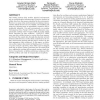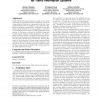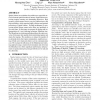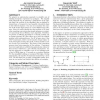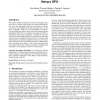GIS
2010
ACM
14 years 11 days ago
2010
ACM
The sensing systems that monitor physical environments rely on communication infrastructures (wired or wireless) to collect data from the sensors embedded in the environment. Howe...
GIS
2010
ACM
14 years 11 days ago
2010
ACM
Recording the location of people using location-acquisition technologies, such as GPS, allows generating life patterns, which associate people to places they frequently visit. Con...
GIS
2010
ACM
14 years 11 days ago
2010
ACM
Traffic information systems based on mobile, in-car sensor technology are a challenge for data management systems as a huge amount of data has to be processed in real-time. Data m...
GIS
2010
ACM
14 years 11 days ago
2010
ACM
We consider the problem of automatically cleaning massive sonar data point clouds, that is, the problem of automatically removing noisy points that for example appear as a result ...
GIS
2010
ACM
14 years 11 days ago
2010
ACM
Spatial Alarms are reminders for mobile users upon their arrival of certain spatial location of interest. Spatial alarm processing requires meeting two demanding objectives: high ...
GIS
2010
ACM
14 years 11 days ago
2010
ACM
Map matching is a fundamental operation in many applications such as traffic analysis and location-aware services, the killer apps for ubiquitous computing. In the past, several m...
GIS
2010
ACM
14 years 11 days ago
2010
ACM
Instead of traditional ways of creating road maps, an attractive alternative is to create a map based on GPS traces of regular drivers. One important aspect of this approach is to...
GIS
2010
ACM
14 years 11 days ago
2010
ACM
GIS
2010
ACM
14 years 11 days ago
2010
ACM
With modern LiDAR technology the amount of topographic data, in the form of massive point clouds, has increased dramatically. One of the most fundamental GIS tasks is to construct...
GIS
2010
ACM
14 years 11 days ago
2010
ACM
Object representation and reasoning in vector based geographic information systems (GIS) is based on Euclidean geometry. Euclidean geometry is built upon Euclid's first postu...
